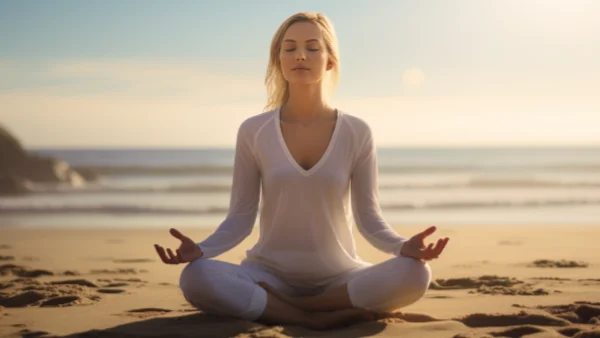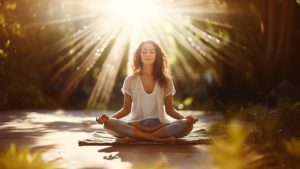
> Feeling burnt out? Subscribe to my Everyday Self-Care Newsletter for self-care tips and doable habits that support your well-being.
Introduction
It’s a buzzword you see all the time now. Mindfulness. Mindful meditation. Living mindfully. When you look it up, you get definitions such as “mindfulness is the psychological process of bringing one’s attention to experiences occurring in the present moment”. If you read into it a little further you’ll soon find out that mindfulness is related to Buddhism and psychologists since the 1970s have been advocating its benefits for depression, anxiety, stress, drug addiction and even helping to stop the onset and development of various forms of mental illness.
When I first read about the benefits of meditation, I became quite excited as it sounded exactly what I’d been searching for. But, like many people, I quickly became confused as to how to learn and practise this much-lauded technique. I live in a small isolated village and don’t have the luxury of heading off for mindfulness meditation lessons each week and I wanted to make a start on this practise as soon as possible.
Many years ago, I read a book called “Flow: The Psychology of Optimal Experience” by Mihaly Csíkszentmihályi, a Hungarian-American psychologist. Flow (often colloquially referred to as ‘being in the zone’ or the ‘flow state of mind‘) is now quite a commonly used term, referring to the highly focused mental state that we can achieve when completely immersed in an activity. This book had a profound effect on me at the time and each time I read something about mindfulness, I can’t help thinking of this book and wondering if these two concepts are somehow related.
In fact, these terms are now almost interchangeable, flow being the state we enter, perhaps by chance, during an activity that we find engrossing, and mindfulness being a more deliberate state of mind that many people including Buddhists try to maintain during every part of their daily lives. They are essentially the same, perhaps just reached through slightly different circumstances and practices.
I have started tentatively to try to put these concepts into place in my life. I’ve gradually found that I can attain this relaxed and focused state of mind through a huge variety of practices and activities. Here are four activities that I have found to be relatively simple yet enormously helpful:
1. Meditation
The most obvious and probably the most reliable way of being mindful, or being ‘in the now’, is through daily meditation. The simple action of sitting quietly and concentrating on the breath is an instant stress-buster and a gateway into mindfulness. In the beginning, it may not be easy to maintain, but simple regular practice will make it easier, and you can extend the length of sessions as your concentration increases.
2. Concentrating on Daily Tasks
This is difficult to remember in the rush of activity of everyday life, but it is essentially a very easy technique. I simply concentrate on what I am doing while I’m doing it. It sounds simple and it actually is, as long as I remember and put in that extra effort, rather than just rushing to get tasks done as quickly as possible.
For example, if I’m gardening, I look closely at the soil, at the weeds that I’m pulling up, or at the plants or branches that I’m trimming. I notice the detail of what I see, hear, feel, and smell, and I concentrate very carefully on every tiny movement that I make. If I’m washing up, I feel the warmth of the water, smell the detergent, look at the shine of the crockery and cutlery, reflections in the numerous bubbles. I simply try to look at everything, use all my other senses to fully engage in the moment, and do everything as if it is for the first time.
A useful way to think of this technique is as if through a camera. Imagine that you are making a film, doing intense close-ups of everything you look at and that you are continually fine-tuning the focus to bring everything into a crystal-clear picture. This technique has the added advantage of making you remember what you have just done.
Instead of wondering if you locked the door, you will have a very vivid memory of it because you were fully present when you did it. I’m convinced that such mindfulness practice can help us maintain our memory as we age, as a lot of poor memory is caused simply by a lack of concentration during tasks that we repeat daily.
3. Listening to Music
We all listen to music, often whether we want to or not, in the supermarket, in the background of a television program or on the radio. But in fact what we are doing is (perhaps) hearing music, as listening implies a more active and purposeful experience rather than an incidental and passive one.
Even if we go to the effort of putting on some music deliberately to listen to it, we often do not give it our full attention. We have the music playing while we are doing the washing up (which we’re also not concentrating on because we’re thinking about what we have to do later in the day…).
As a mindfulness exercise, I often put on a favorite piece of music and sit and listen with my eyes closed. I use it as a form of meditation, concentrating fully on what I am hearing, noticing the different instruments and voices, the words, the way the music has been recorded and produced, and the emotional effect it has on me. Inevitably my mind will wander but, as with all meditation, I just gently guide it back to the music as soon as I notice.
4. Engrossing Hobbies
Hobbies are a wonderful way to effortlessly get ‘into the flow’. They have to be something that really interests you and that you can easily immerse yourself in. I find that walking in nature, playing instruments, singing, drawing or coloring are all incredibly relaxing and engrossing. It’s different for everyone; sports are a favorite for many people, as is the cinema, reading novels, doing jigsaw puzzles, crafts of all types, and gardening and DIY.
Final Thoughts
Whether we call it flow or mindfulness, whether we reach this focused state of mind through intent or through the intense focus we bring to activities we love, the benefits of this state of mind are undoubtable. We breathe better and deeper, we relax, we forget our worries and we find a new appreciation of things that can otherwise become laborious chores. Just trying one or two simple techniques can lift your day-to-day routine out of the ordinary and into a beautiful relaxing experience. Thanks for reading!


